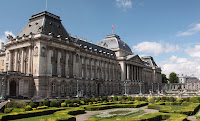Belgium's
fascinating capital, and the administrative capital of the EU,
Brussels is historic yet hip, bureaucratic yet bizarre, self confident
yet unshowy, and multicultural to its roots. These contrasts are
multilayered – Francophone alongside Flemish, and Eurocrats
cheek-by-jowl with immigrants. And all this plays out in a cityscape
that swings from majestic to quirky to rundown and back again. Organic
art-nouveau facades face off against 1960s concrete disgraces, and
regal 19th-century mansions contrast with the brutal glass of the EU’s
Gotham City. This whole maelstrom swirls out from Brussels’ medieval
core, where the Grand Place is surely one of the world’s most beautiful
squares. One constant is the enviable quality of everyday life, with a
café/bar scene that could keep you drunk for years. But Brussels
doesn’t go out of its way to impress. The citizens’ humorous, deadpan
outlook on life is often just as surreal as the canvases of one-time
resident Magritte.
If ever a city could claim split
personality, it’s Brussels. French versus Flemish, historic versus hip,
bizarre versus boring. Full of contrasts, contradictions and intrigue,
this is a multicultural equation that goes much deeper than just red
tape and Eurocrats. An historic heirloom is closer to the mark. And in
an age where so much is already discovered,
Belgium’s capital seduces as one of Western Europe’s unknowns.

Brussels is a city of fine food,
café culture,
Art Nouveau architecture and the surreal. Pull up a chair and join
laissez-faire locals who value the city’s casual atmosphere. Watch money
go down on swish Ave Louise or buy dried caterpillars just blocks away
in Matonge, the capital’s African quarter. Some of the world’s most
enduring images of surrealist art were created in the nondescript
northern suburb of Jette. And the architecture ranges from monumental
edifices such as the Grand Place to organic Art Nouveau façades and the
EU’s real-life Gotham City. Constant among all this is the quality of
everyday life – the shopping’s great, the restaurants fab, the chocolate
shops sublime and the pub scene extraordinary. For a long time Brussels
didn’t go out of its way to impress, but its stint as Cultural Capital
of
Europe in 2000 saw the city dusted and polished in a flurry that brought renewed life to historic buildings and decaying streets.
A
new spirit, just short of cockiness, emerged, flaming outside interest
and inner-city regeneration. Nearly a decade on, Brussels is looking
better than ever.
 Show in Lonely Planet
Show in Lonely Planet

 Brussels is a city of fine food, café culture,
Art Nouveau architecture and the surreal. Pull up a chair and join
laissez-faire locals who value the city’s casual atmosphere. Watch money
go down on swish Ave Louise or buy dried caterpillars just blocks away
in Matonge, the capital’s African quarter. Some of the world’s most
enduring images of surrealist art were created in the nondescript
northern suburb of Jette. And the architecture ranges from monumental
edifices such as the Grand Place to organic Art Nouveau façades and the
EU’s real-life Gotham City. Constant among all this is the quality of
everyday life – the shopping’s great, the restaurants fab, the chocolate
shops sublime and the pub scene extraordinary. For a long time Brussels
didn’t go out of its way to impress, but its stint as Cultural Capital
of Europe in 2000 saw the city dusted and polished in a flurry that brought renewed life to historic buildings and decaying streets.
Brussels is a city of fine food, café culture,
Art Nouveau architecture and the surreal. Pull up a chair and join
laissez-faire locals who value the city’s casual atmosphere. Watch money
go down on swish Ave Louise or buy dried caterpillars just blocks away
in Matonge, the capital’s African quarter. Some of the world’s most
enduring images of surrealist art were created in the nondescript
northern suburb of Jette. And the architecture ranges from monumental
edifices such as the Grand Place to organic Art Nouveau façades and the
EU’s real-life Gotham City. Constant among all this is the quality of
everyday life – the shopping’s great, the restaurants fab, the chocolate
shops sublime and the pub scene extraordinary. For a long time Brussels
didn’t go out of its way to impress, but its stint as Cultural Capital
of Europe in 2000 saw the city dusted and polished in a flurry that brought renewed life to historic buildings and decaying streets. Show in Lonely Planet
Show in Lonely Planet



















Комментариев нет:
Отправить комментарий